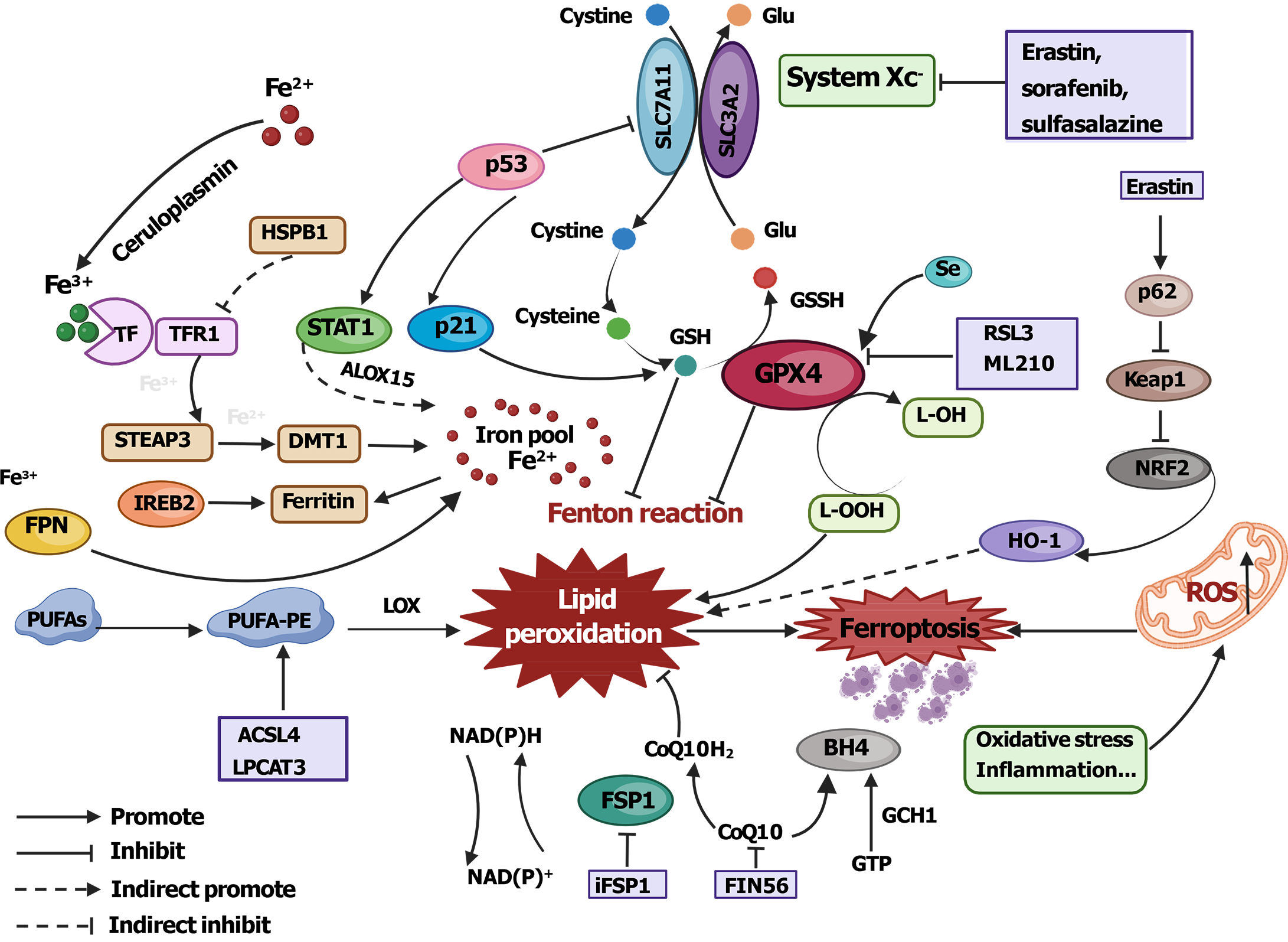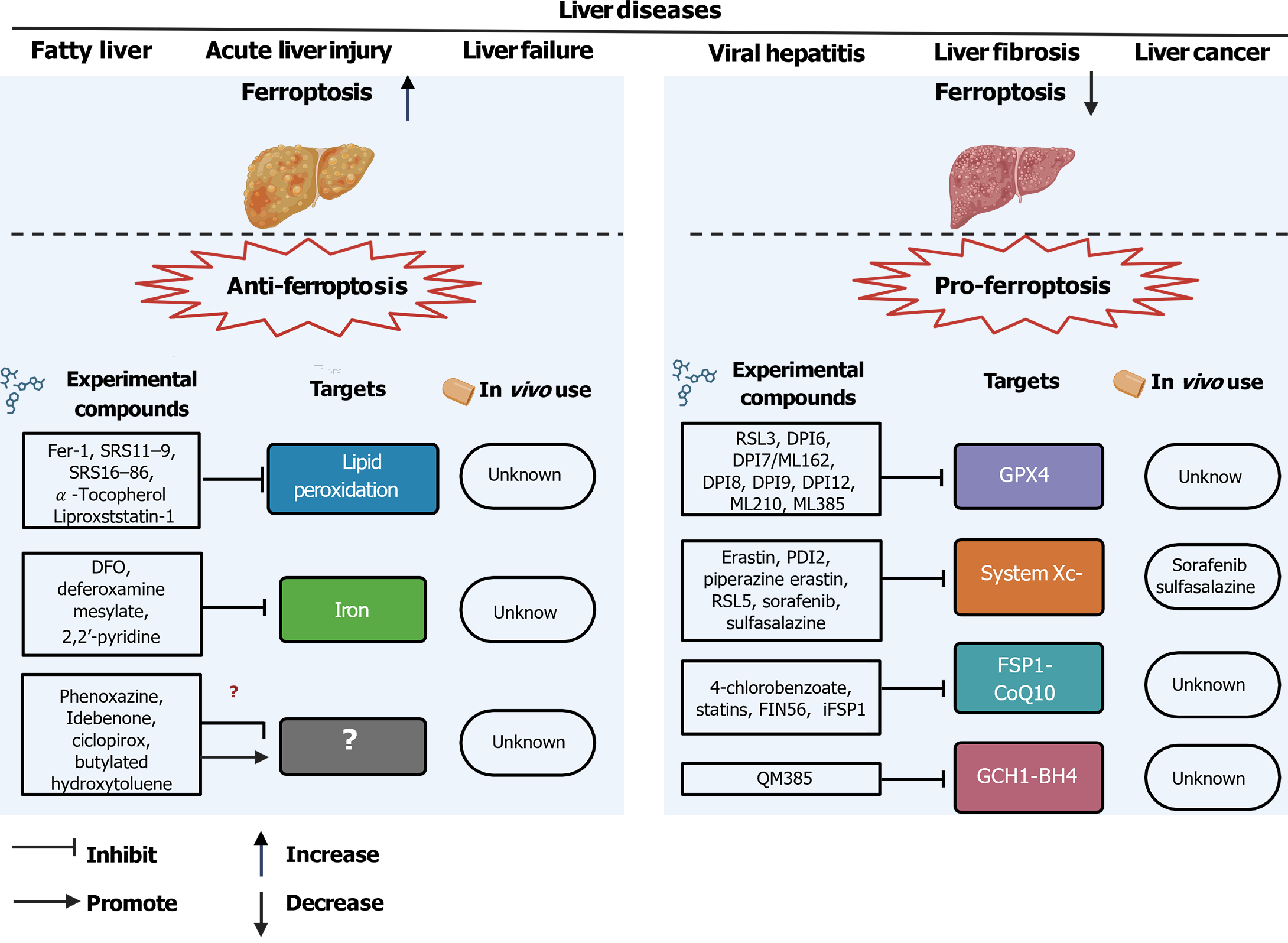Copyright
©The Author(s) 2024.
World J Gastroenterol. Aug 28, 2024; 30(32): 3730-3738
Published online Aug 28, 2024. doi: 10.3748/wjg.v30.i32.3730
Published online Aug 28, 2024. doi: 10.3748/wjg.v30.i32.3730
Figure 1 Mechanisms by which glutathione peroxidase 4, iron homeostasis, lipid peroxidation, and regulation of some key genes influence ferroptosis.
The diagram illustrates the regulatory pathways of ferroptosis, which can be categorized into three main groups. The gluta-thione/glutathione peroxidase 4 pathway plays a role in regulating several processes, such as system Xc- inhibition, glutamine metabolism, and the p53 signaling axis. Furthermore, iron metabolism is influenced by regulatory mechanisms such as the p62-kelch like ECH associated protein 1-nuclear factor erythroid 2-related factor 2 pathway. Finally, the pathways associated with lipid metabolism, namely, p53-SAT1-arachidonate (15S)-lipoxygenase, acyl coenzyme a synthetase long chain family, member 4, and lysophosphatidylcholine acyltransferase 3, play an important role regulating lipids and enhancing the rate of ferroptosis. In addition, the ferroptosis-coenzyme Q10-nicotinamide adenine dinucleotide phosphate pathway prevents phospholipid peroxidation and inhibits ferroptosis. Glu: Glutamic acid; NRF2: Nuclear factor erythroid 2-related factor 2; SLC7A11: Solute carrier family 7 member 11; SLC3A2: Solute carrier family 3 member 2; System Xc-: Cystine/glutamate antiporter (Xc-) system; GSH: Glutathione; GSSH: Glutathione oxidized; GPX4: Glutathione peroxidase 4; ROS: Reactive oxygen species; GTP: Guanosine triphosphate; CoQ10: Coenzyme Q10; CoQ10H2: Reduced coenzyme Q-10; GCH1: GTP cyclohydrolase 1; BH4: Tetrahydrobiopterin; NADPH: Nicotinamide adenine dinucleotide phosphate; HO-1: Heme oxygenase-1; L-OH: Lipid hydrogen peroxide; L-OOH: Lipid peroxide; ALOX15: Arachidonate (15S)-lipoxygenase; LOX: Lysine oxidase; ACSL4: Acyl coenzyme a synthetase long chain family, member 4; LPCAT3: Lysophosphatidylcholine acyltransferase 3; iFSP1: Inhibitor of ferroptosis; FSP1: Ferroptosis; PUFAs: Polyunsaturated fatty acids; PUFA-PE: Polyunsaturated fatty acids-phosphatidylethanolamine; FPN: Ferroportin; STEAP3: Six transmembrane epithelial antigen of the prostate 3; DMT1: Divalent metal transporter 1; IREB2: Iron-regulated element binding protein 2; TF: Transferrin; TFR1: Transferrin receptor 1; HSPB1: Heat shock protein beta-1; Keap1: Kelch like ECH associated protein 1.
Figure 2 Strategies targeting ferroptosis for treatment of liver diseases.
Ferroptosis has been associated with various liver diseases, including fatty liver disease, acute liver injury, chronic and acute liver failure, hepatitis, liver fibrosis/cirrhosis, and liver cancer. Compounds that inhibit or induce ferroptosis have the potential to impact the development of liver diseases. System Xc-: Cystine/glutamate antiporter (Xc-) system; GPX4: Glutathione peroxidase 4; CoQ10: Coenzyme Q10; GCH1: Guanosine triphosphate cyclohydrolase 1; BH4: Tetrahydrobiopterin.
- Citation: Lai MS, Yan XP, Branch DR, Loriamini M, Chen LM. Ferroptosis in liver diseases: Fundamental mechanism and clinical implications. World J Gastroenterol 2024; 30(32): 3730-3738
- URL: https://www.wjgnet.com/1007-9327/full/v30/i32/3730.htm
- DOI: https://dx.doi.org/10.3748/wjg.v30.i32.3730










